Warning — long blog post ahead!
I’ve been promising to post something about our new catalogue PCs …but first, a bit of background:
Like most large(ish) academic libraries, we’ve got dedicated catalogues PCs… lots of them… on every floor! From memory, we had at least 35 of them before the start of the refurbishment. We tended to use PCs that were no longer suitable for staff and they’d often be 5 or 6 years old. Unless staff remembered to turn them off every evening, chances are they’d get left on 24/7.
After a quick Google search, it looks like the average PC & monitor uses around 2.5 pence (UK) per hour (probably more now that electricity costs have risen in the last 12 months). So, if left on 24/7, then it would use 60 pence per day, £4.20 per week, or around £218 per year. Multiply that up by the total number of PCs (35) and we might have been paying around £7,600 per year! :-S
When I saw the plans for the refurbished floors, the first thing I noted was that there was an increased number of catalogue PCs on each floor (bringing to grand total to 45). Again, if left on 24/7, that could cost us nearly £10,000 per year.
Anyway, a couple of things coincided this summer. Firstly, the University (which has been busy improving recycling, etc) was crowned the “Most Improved University” in the annual People & Planet’s Green League table (more info here). Secondly, at the Poster Promenade event in June, I spotted something interesting on one of the stands…

On the left-hand side of that photo is a small black box with a cool blue LED — a Viglen MPC-L mini PC. It ships with Xubuntu Linux, 256MB of memory and a 80GB hard drive, and has all the usual connections that you’d see on a PC (6xUSB, VGA, audio, and network). There’s no fan inside, and the metal case acts as a large heatsink for the low spec’d CPU.
Our IT Dept had evaluated them, but the non-standard operating system and the relatively poor performance had put them off. However, they looked ideal for catalogue PCs and, according to the Viglen web site, they only use £1 of electricity per year!
A quick hunt around on the Viglen web site also threw up the fact that they can be purchased with a VESA mount, so the PC can be attached to the back of a flat screen monitor — potentially a huge space saver.
Due to the limited time available, I didn’t fancy trying to figure out how to run Xubuntu as a PAC and instead I installed XP and configured it in the same way as our other catalogue PCs (using Public Web Browser as the Windows shell). The mini PC is *just* about powerful enough to run a web browser smoothly. We normally use McAfee antivirus on University PCs, but that killed the mini PC (it uses far too much CPU and too much memory), so I went with a freebie antivirus option instead.
The mini PCs weren’t too difficult to image. After finally managing to get Norton Ghost to run off a USB drive, it took about 20 minutes to image each mini PC.
So, enough talk, let’s get to the good bit with some pictures!
First of all, you’ll need a TFT monitor with 4 VESA mounting holes on the back:
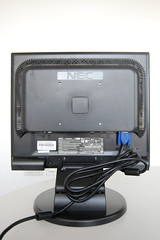
The VESA mounting cage for the mini PC looks like this:
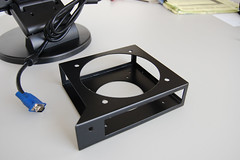
You can see the mini PC connections on these two photos:
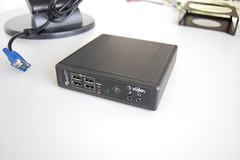
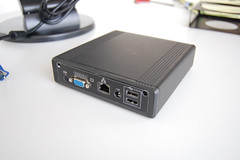
And here you can get a feel for the size (that’s a 17″ TFT monitor behind it):
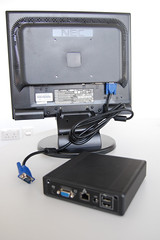
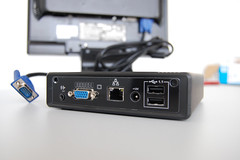
The mini PC would have no problems fitting into a 5.25″ drive bay on a standard PC:
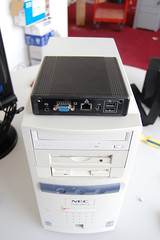
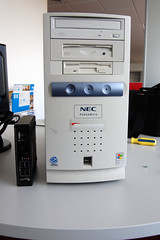
Here’s the mini PC inside its cage:
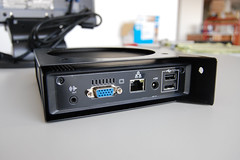

Next up, you screw the cage onto the back of the monitor:
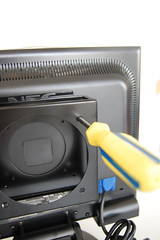
Shame they don’t bundle a short VGA lead with the PC!:
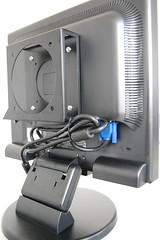
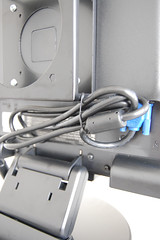
Then slip the mini PC into its cage and hook up the VGA cable:

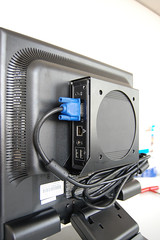
The whole thing is secured using a padlock, which traps all the cables (no more stolen mice!):
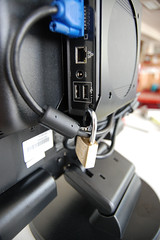
From above, you can see just how small the mini PC is:
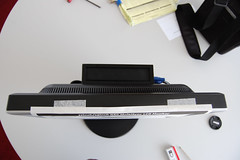

Setting them up took a little bit of time, as tidying up the various cables so that they’re hidden behind the TFT is a bit tricky:


And, voila — 6 new eco-friendly catalogue PCs and not an ugly PC base unit in sight!

I set the mini PCs up to drop the monitor into standby after 15 minutes, so hopefully we’re going to save a few thousand pounds in electricity this year and maybe we’ll manage to stay in the top 10 in next years’ Green League table 🙂
—-
[edit] I forgot to mention that the mini PC is powered using a 12 volt laptop style power adaptor.
14 thoughts on “Green eco-friendly catalogue PCs”
Comments are closed.
Also forgot to mention the price — the mini PCs are currently £99 ex vat on the Viglen web site. After extending the warranty to 3 years and adding in the VESA mounts, keyboards & mice, I think it came to around £135 ex vat.
I’m not too sure how much electricity a TFT uses, but I think there’s a good chance the PCs will have paid for themselves in less than a year.
So cool! What a great idea!
Excellent stuff. I saw something similar to these mini-PCs a while back and thought they could work well in a library context, but of course, never got round to doing anything about it. Anyway, lots of props from me…
Cheers Owen — touch wood, the mini-PCs have been running fine so far and are getting heavy usage (partly because I’ve only been able to deploy half of them so far on each floor due to problems with some of the new furniture)
Hi there – a very interesting post! I’m especially interested that you managed to get XP running on the Viglens. I wonder if I could ask you some questions about how well it runs? Feel free to reply to my email. Again, great post!
Hi Ronan
The Viglens can just about run Windows XP, although it feels a little sluggish. On our PACs, we’re using PWB as the operating system shell, so they’re not having to run the normal Windows desktop. As well as making them a little more secure (i.e. you can get to any icons, shortcuts, etc), not having the XP desktop running means that the performance is better.
Argggh! We seem to have slipped out of the top 10 in the Green League 2009, but we’re still in the top 20.
If anyone’s interested, the Viglens are still going strong and we’ve not had a single problem with any of them 🙂
Hi Dave,
Just some feedback. We are building our new eco-friendly library and someone just asked me about a solution for ugly OPACs, and after a bit of hunting around I managed to find this post. I remembered you had done something like this, but forgotten the eco-friendly bit.
Thank you once again for being a damn handy bloke to know on the internet.
🙂
I’m guessing the new Acer Revo won’t have a high energy consumption too.
The VESA mount is quite cool – definite space saver there. A bit of a bummer if you’ve got screens where the stand attaches to the the VESA though.
Just wondering what makes PWB + XP better than a kiosk Linux system? Is it simply ease of installation, or a mandate from on high to use XP?
I think it’s “horses for courses” — the library doesn’t run or support any Linux systems, so it made sense for us to go with a Windows setup. I suspect a Linux kiosk would run more quickly tho.
Thanks for sharing this Dave. I could see these as being useful in shared premises, joint service centres and the like, where space is a highly fought-over resource.
Nick — I forgot to mention that if the stand screws into the VESA mounting holes (rather than being moulded onto the back) then it should still work as the Viglen mount comes with nuts that look like they’ll allow a stand to be screwed to the other side of the cage.